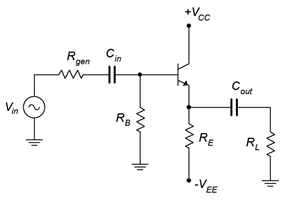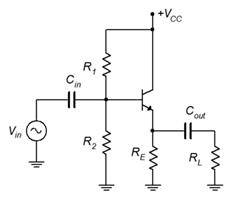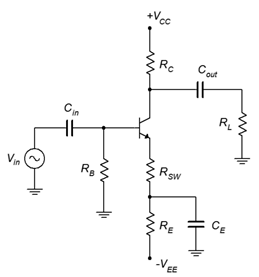8.8: Exercises
- Page ID
- 34250
8.8.1: Analysis Problems
1. Draw the AC load line for the circuit of Figure \(\PageIndex{1}\). Also determine the compliance, maximum load power, maximum transistor dissipation and efficiency. \(V_{CC}\) = 6 V, \(V_{EE}\) = −12 V, \(R_{gen}\) = 50 \(\Omega\), \(R_B\) = 2.2 k\(\Omega\), \(R_E\) = 470 \(\Omega\), \(R_L\) = 75 \(\Omega\).

Figure \(\PageIndex{1}\)
2. Recalculate Problem 1 if the load is halved.
3. Determine if the circuit of Figure \(\PageIndex{2}\) has a centered Q point on its AC load line. \(V_{CC}\) = −10 V, \(V_{EE}\) = 15 V, \(R_B\) = 1 k\(\Omega\), \(R_E\) = 330 \(\Omega\), \(R_L\) = 50 \(\Omega\).

Figure \(\PageIndex{2}\)
4. Draw the AC load line for the circuit of Figure \(\PageIndex{2}\). Also determine the compliance, maximum load power, maximum transistor dissipation and efficiency. \(V_{CC}\) = −8 V, \(V_{EE}\) = 12 V, \(R_B\) = 1 k\(\Omega\), \(R_E\) = 330 \(\Omega\), \(R_L\) = 32 \(\Omega\).
5. Draw the AC load line for the circuit of Figure \(\PageIndex{3}\). Also determine the compliance, maximum load power, maximum transistor dissipation and efficiency. \(V_{CC}\) = 15 V, \(V_{EE}\) = −20 V, \(R_B\) = 10 k\(\Omega\), \(R_E\) = 100 \(\Omega\), \(R_L\) = 16 \(\Omega\).

Figure \(\PageIndex{3}\)
6. Determine if the circuit of Figure \(\PageIndex{4}\) has a centered Q point on its AC load line. \(V_{CC}\) = 30 V, \(R_1\) = 3.9 k\(\Omega\), \(R_2\) = 3.3 k\(\Omega\), \(R_E\) = 560 \(\Omega\), \(R_L\) = 50 \(\Omega\).

Figure \(\PageIndex{4}\)
7. Draw the AC load line for the circuit of Figure \(\PageIndex{4}\). Also determine the compliance, maximum load power, maximum transistor dissipation and efficiency. \(V_{CC}\) = 30 V, \(R_1\) = 2.2 k\(\Omega\), \(R_2\)= 2.2 k\(\Omega\), \(R_E\) = 470 \(\Omega\), \(R_L\) = 32 \(\Omega\).
8. Determine if the circuit of Figure \(\PageIndex{5}\) has a centered Q point on its AC load line. \(V_{CC}\) = 15 V, \(V_{EE}\) = −15 V, \(R_B\) = 1 k\(\Omega\), \(R_E\) = 510 \(\Omega\), \(R_{SW}\) = 10 \(\Omega\), \(R_C\) = 270 \(\Omega\), \(R_L\) = 50 \(\Omega\).

Figure \(\PageIndex{5}\)
9. Draw the AC load line for the circuit of Figure \(\PageIndex{5}\). Also determine the compliance, maximum load power, maximum transistor dissipation and efficiency. \(V_{CC}\) = 25 V, \(V_{EE}\) = −15 V, \(R_B\) = 1 k\(\Omega\), \(R_E\) = 270 \(\Omega\), \(R_{SW}\) = 6.8 \(\Omega\), \(R_C\) = 330 \(\Omega\), \(R_L\) = 16 \(\Omega\).
10. A power transistor has a \(P_{D(max)}\) of 50 watts at 25\(^{\circ}\)C. It has a derating factor of 0.4 W/C\(^{\circ}\). Will this transistor be sufficient for a circuit that needs to dissipate 40 watts at 85\(^{\circ}\)C?
11. A power transistor has a \(P_{D(max)}\) of 100 watts at 25\(^{\circ}\)C. It has a derating factor of 0.6 W/C\(^{\circ}\). Will this transistor be sufficient for a circuit that needs to dissipate 65 watts at 75\(^{\circ}\)C?
12. Determine the appropriate heat sink rating for a power device rated as follows: \(T_{j(max)}\) = 175\(^{\circ}\)C, TO-3 case style, \(\theta_{jc}\) = 1.5 C\(^{\circ}\)/W. The device will be dissipating a maximum of 25 W in an ambient temperature of 35\(^{\circ}\)C. Assume that the heat sink will be mounted with heat sink grease and a 0.003 mica insulator.
13. Determine the appropriate heat sink rating for a power device rated as follows: \(T_{j(max)}\) = 165\(^{\circ}\)C, TO-220 case style, \(\theta_{jc}\) = 3 C\(^{\circ}\)/W. The device will be dissipating a maximum of 15 W in an ambient temperature of 35\(^{\circ}\)C. Assume that the heat sink will be mounted with heat sink grease and a 0.002 mica insulator.
8.8.2: Design Problems
14. Alter the emitter power supply in the circuit described in Problem 1 to achieve a centered Q point.
15. Alter the emitter power supply in the circuit described in Problem 4 to achieve a centered Q point.
8.8.3: Challenge Problems
16. Find a heat sink (make and model number) that will meet the thermal resistance requirement for Problem 12 with no more than 400 feet/minute of forced air.
17. Alter the voltage divider in the circuit described in Problem 6 to achieve a centered Q point.
8.8.3: Computer Simulation Problems
18. Perform a transient analysis for the circuit described in Problem 1 to verify the compliance.
19. Perform a transient analysis for the circuit described in Problem 4 to verify the compliance.
20. Perform a transient analysis for the circuit described in Problem 9 to verify the compliance.


